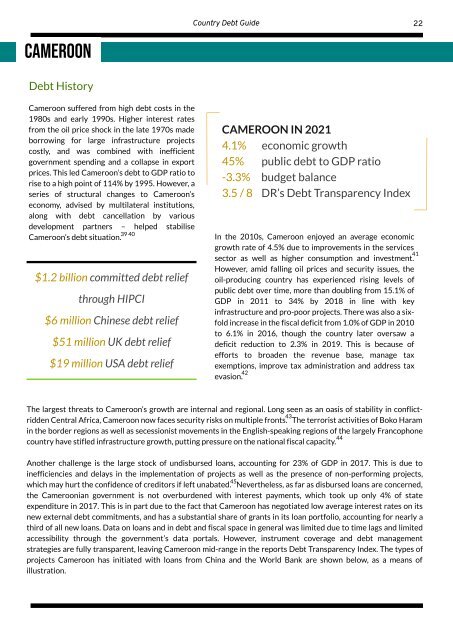You also want an ePaper? Increase the reach of your titles
YUMPU automatically turns print PDFs into web optimized ePapers that Google loves.
Country <strong>Debt</strong> <strong>Guide</strong><br />
22<br />
Cameroon<br />
<strong>Debt</strong> History<br />
Cameroon suffered from high debt costs in the<br />
1980s and early 1990s. Higher interest rates<br />
from the oil price shock in the late 1970s made<br />
borrowing for large infrastructure projects<br />
costly, and was combined with inefficient<br />
government spending and a collapse in export<br />
prices. This led Cameroon’s debt to GDP ratio to<br />
rise to a high point of 114% by 1995. However, a<br />
series of structural changes to Cameroon’s<br />
economy, advised by multilateral institutions,<br />
along with debt cancellation by various<br />
development partners – helped stabilise<br />
39 40<br />
Cameroon’s debt situation.<br />
$1.2 billion committed debt relief<br />
through HIPCI<br />
$6 million Chinese debt relief<br />
$51 million UK debt relief<br />
$19 million USA debt relief<br />
CAMEROON IN 2021<br />
4.1% economic growth<br />
45% public debt to GDP ratio<br />
-3.3% budget balance<br />
3.5 / 8 DR’s <strong>Debt</strong> Transparency Index<br />
In the 2010s, Cameroon enjoyed an average economic<br />
growth rate of 4.5% due to improvements in the services<br />
sector as well as higher consumption and investment.<br />
However, amid falling oil prices and security issues, the<br />
oil-producing country has experienced rising levels of<br />
public debt over time, more than doubling from 15.1% of<br />
GDP in 2011 to 34% by 2018 in line with key<br />
infrastructure and pro-poor projects. There was also a sixfold<br />
increase in the fiscal deficit from 1.0% of GDP in 2010<br />
to 6.1% in 2016, though the country later oversaw a<br />
deficit reduction to 2.3% in 2019. This is because of<br />
efforts to broaden the revenue base, manage tax<br />
exemptions, improve tax administration and address tax<br />
42<br />
evasion.<br />
41<br />
The largest threats to Cameroon’s growth are internal and regional. Long seen as an oasis of stability in conflictridden<br />
Central Africa, Cameroon now faces security risks on multiple fronts. The terrorist activities of Boko Haram<br />
43<br />
in the border regions as well as secessionist movements in the English-speaking regions of the largely Francophone<br />
44<br />
country have stifled infrastructure growth, putting pressure on the national fiscal capacity.<br />
Another challenge is the large stock of undisbursed loans, accounting for 23% of GDP in 2017. This is due to<br />
inefficiencies and delays in the implementation of projects as well as the presence of non-performing projects,<br />
45<br />
which may hurt the confidence of creditors if left unabated. Nevertheless, as far as disbursed loans are concerned,<br />
the Cameroonian government is not overburdened with interest payments, which took up only 4% of state<br />
expenditure in 2017. This is in part due to the fact that Cameroon has negotiated low average interest rates on its<br />
new external debt commitments, and has a substantial share of grants in its loan portfolio, accounting for nearly a<br />
third of all new loans. Data on loans and in debt and fiscal space in general was limited due to time lags and limited<br />
accessibility through the government’s data portals. However, instrument coverage and debt management<br />
strategies are fully transparent, leaving Cameroon mid-range in the reports <strong>Debt</strong> Transparency Index. The types of<br />
projects Cameroon has initiated with loans from China and the World Bank are shown below, as a means of<br />
illustration.


